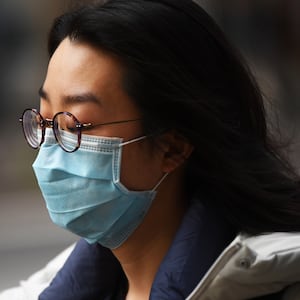Hours after a chartered plane full of nearly 200 Americans returned from Wuhan, China on Wednesday, the World Health Organization reconvened an emergency committee to discuss the outbreak that began in that city and has now eclipsed the number of SARS infections during a 2003 epidemic.
A Kalitta Air Boeing 747 carrying American diplomats and citizens was evacuated from the epicenter of the novel 2019 coronavirus outbreak on Tuesday and landed for a layover and medical screenings at Ted Stevens Anchorage International Airport in Alaska just after 9 p.m. local time, The New York Times reported. Passengers expressed relief and joy at re-entering their home country.
“The whole plane erupted in cheers when the crew said, ‘Welcome home to the United States,’” said Anne Zink, Alaska’s chief medical officer, describing it as “a moving and uplifting experience.”
ADVERTISEMENT
The passengers underwent two medical screenings in China before boarding and two more screenings upon their layover in Alaska before they were approved by staff members of the U.S. Centers for Disease Control and Prevention to get back on the plane, according to Zink.
Once it refueled in Alaska, the plane took off for its final destination at March Air Reserve Base in Riverside County, California. It landed about 65 miles east of Los Angeles just after 8 a.m. local time on Wednesday morning, according to the flight tracking site Flightradar24. Passengers were to go through additional health screenings at the base and be “temporarily housed for a period of time,” according to Alaska’s Department of Health and Social Services.
A team of CDC medical officers met the group in California to take over the screening process and to conduct “risk assessments to ensure the health of each traveler, including temperature checks and observing for respiratory symptoms,” the agency said in a press release on Wednesday. The California Department of Public Health and Riverside County Public Health will transport any passenger with such symptoms to a hospital, according to the CDC.
“We have taken every precaution to ensure their safety while also protecting the safety of the nation,” said Dr. Nancy Messonnier, director of the CDC’s National Center for Immunization and Respiratory Diseases, who noted that there were 20 CDC staff on the base to help manage the screenings. All of the passengers were still without coronavirus symptoms, had been given assigned living quarters, and had agreed to remain on the base voluntarily.
“I understand that many people in the United States are worried about this virus and how it will affect them,” Messonnier added. “But we are well prepared.”
Meanwhile, Chinese officials said on Wednesday that at least 132 people had died from the virus in that country, and more than 5,974 individuals had been confirmed with infections. That number now exceeds the tally of 5,327 people infected with the Severe Acute Respiratory Syndrome (SARS) coronavirus that killed about 800 people worldwide in 2002 and 2003.
“Leading scientists are now indicating that the coming 10 days will be crucial for that containment effort,” said Yanzhong Huang, a senior fellow for global health at the Council on Foreign Relations. “If everything goes well, the cases will start to go down in 10 days.”
In response to the heightened death toll, Dr. Tedros Adhanom Ghebreyesus, director-general of the World Health Organization, announced on Wednesday that he will reconvene the International Health Regulations Emergency Committee on Thursday to re-evaluate its decision not to declare the outbreak a global public health emergency. Such a designation would allow the organization increased authority in coordinating global responses to the spread of the virus.
During a press conference in Geneva on Wednesday, Tedros said he had visited Beijing a day earlier to get a first-hand look at the crisis and that an international team of WHO scientists were already on the ground assisting with the outbreak after China initially refused international assistance, including from the CDC.
“I appreciate such openness and urge this to continue from China and all other countries,” Tedros said.
Also on Wednesday, scientists in Australia said they had developed a new lab-grown version of the virus that they planned to share with world public health officials in the hopes of quickening efforts to detect and eventually create a vaccine against the virus. It was the first sample of the novel 2019 coronavirus recreated outside China, Reuters reported.
Tedros on Wednesday noted that at least 68 confirmed cases have been recorded to date outside of China—in Germany, the United Arab Emirates, Thailand, Taiwan, Australia, Macau, Singapore, Japan, South Korea, Malaysia, France, Canada, Vietnam, and Nepal. Almost all of those cases involved people who had traveled to China recently, but authorities said they had confirmed person-to-person transmission in Germany, Vietnam, and Japan. There have been no reported deaths outside China.
“The whole world needs to be on alert now,” said Dr. Michael Ryan, executive director of the WHO’s Health Emergencies Program. “This disease is still spreading person-to-person through individuals.”
France, South Korea, Japan, Morocco, Germany, Kazakhstan, Britain, Canada, Russia, the Netherlands, Myanmar, and Australia have also either evacuated their citizens from Wuhan or plan to imminently. Several international airlines have suspended or reduced flights to China for the next several weeks, including American Airlines, United, and British Airways. Cathay Pacific and Air Canada have also reportedly indicated they would reduce service to mainland China.
Stateside, the CDC said Wednesday that a total of 165 people were “under investigation” for the virus in 36 states. Sixty-eight of those cases tested negative and only five positive. The remainder were still being tested. All of the confirmed U.S. cases involved patients who had recently traveled from Wuhan, and there have been no confirmed person-to-person transmissions inside the United States, CDC officials have said.
The confirmed cases in the U.S. include patients at Arizona State University in Tempe; in Orange County, California; a man in his 30s in Washington state; a passenger who felt ill after flying into Los Angeles International Airport; and a woman in her 60s in Chicago.







